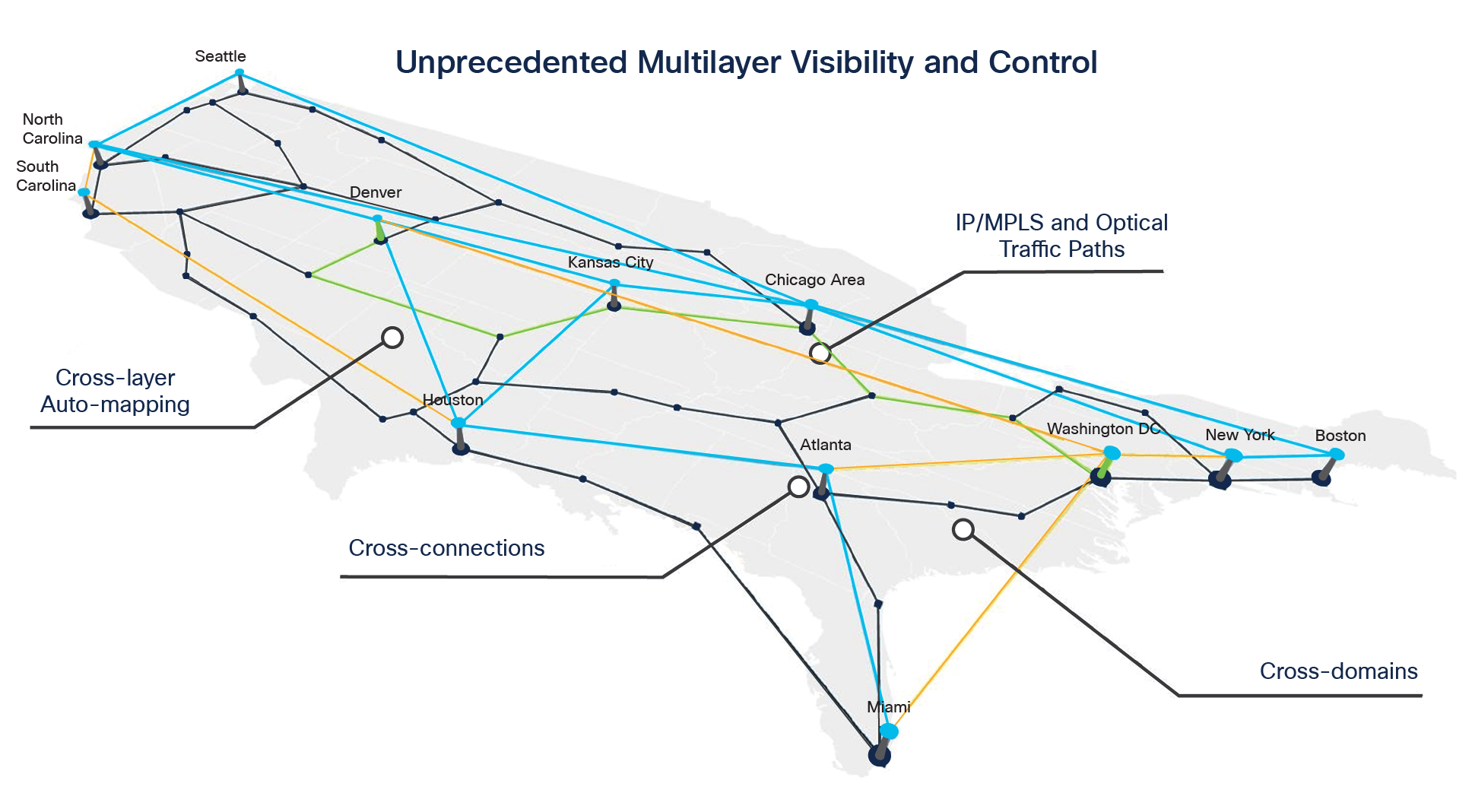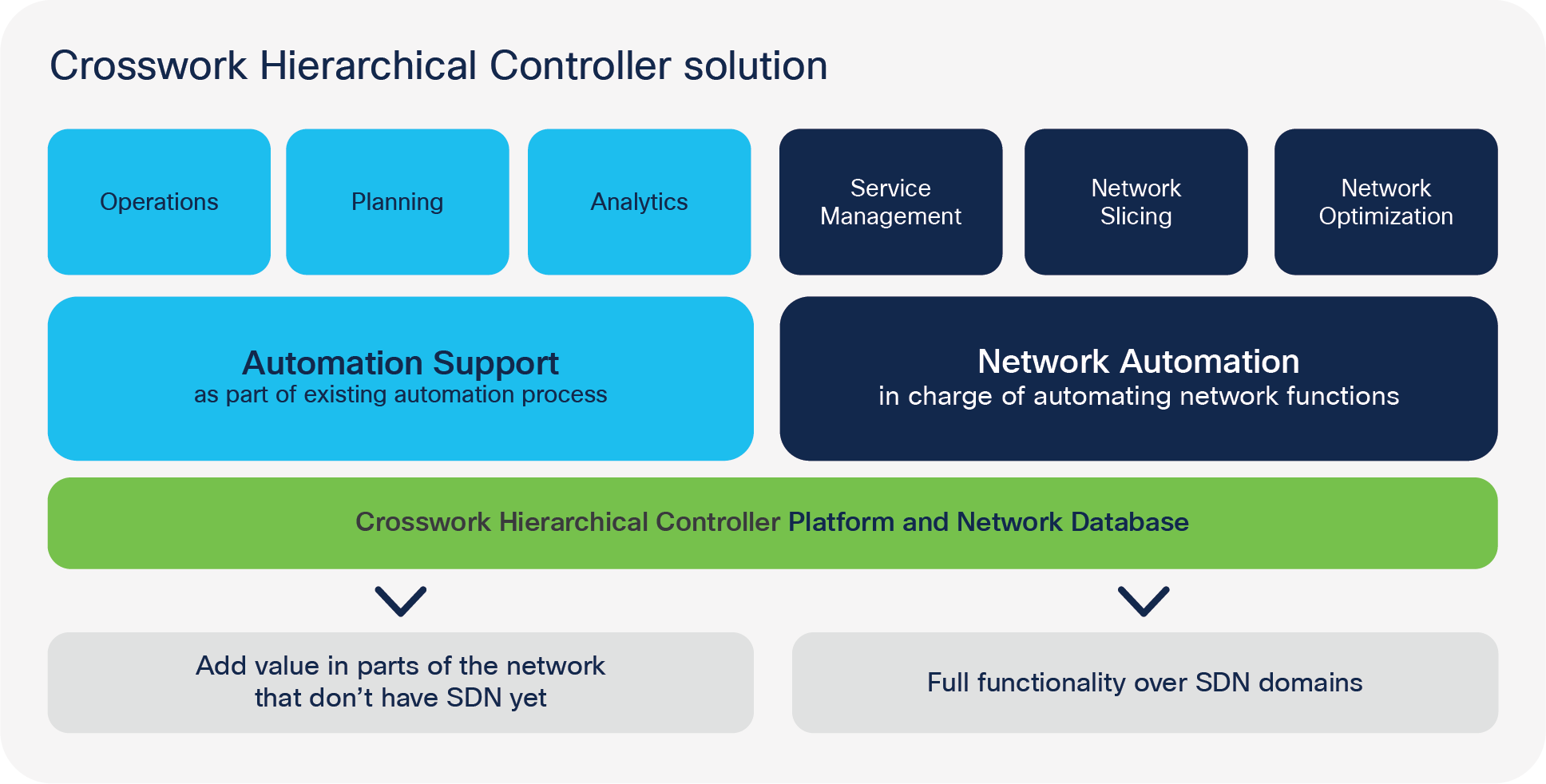IP/Optical Visibility and Control with Cisco Crosswork Hierarchical Controller White Paper
Available Languages
Bias-Free Language
The documentation set for this product strives to use bias-free language. For the purposes of this documentation set, bias-free is defined as language that does not imply discrimination based on age, disability, gender, racial identity, ethnic identity, sexual orientation, socioeconomic status, and intersectionality. Exceptions may be present in the documentation due to language that is hardcoded in the user interfaces of the product software, language used based on RFP documentation, or language that is used by a referenced third-party product. Learn more about how Cisco is using Inclusive Language.
Without understanding the connectivity and dependencies between network layers, you are likely unaware of the wasted CapEx and OpEx spent on deploying, operating, maintaining, and troubleshooting the network. The Cisco Crosswork® Hierarchical Controller solution addresses these issues with products that focus on integrated discovery and control of the IP/MPLS and optical layers.
Networks are comprised of layers. That’s a simple fact. But do you truly understand the connectivity and dependencies between those layers? If not, you likely are unaware of the wasted CapEx and OpEx spent on deploying, operating, maintaining, and troubleshooting the network.
The Cisco Crosswork Hierarchical Controller addresses these issues with products that focus on integrated discovery and control of the IP/MPLS and optical layers.
● The Hierarchical Controller’s discovery and visibility capabilities provide automatic multilayer, multivendor, multidomain visibility into the network.
● Hierarchical Controller’s analytics capabilities deliver powerful, immediate, and accurate network analytics.
● Hierarchical Controller extends these capabilities to enable read-only, user-initiated, and automated apps that enable both optically aware IP/MPLS routing and IP-informed optical switching.
Accurate, automated multilayer discovery and visibility
The lack of insight into dependencies between the network layers is costing millions in CapEx due to planning uncertainty. Data from three Tier 1 service providers suggests that 55 to 75 percent of physical 100-G IP interfaces run at less than 20 percent peak utilization. This means that only 20 percent of network CapEx is allocated for actually carrying traffic, while much of the remaining 80 percent is wasted on overprovisioning to protect the network. Even with other protection mechanisms in place, such as fast reroute and secondary LSPs, a significant number of optical links that fail cause IP/MPLS congestion. This is because the data set for determining how to provision IP links is often outdated or nonexistent, resulting in shared risks at either layer. Examples of such shared risks include LSP paths not being disjoint and IP links using common SRLGs (shared-risk link groups).
This same lack of multilayer insight also results in significant OpEx. Consider that network planners forecast traffic and routes every three to four months to decide how many IP and optical links to provide and where best to place them. This planning of a multilayer network requires laborious, inefficient communication across multiple teams.
The key to reducing these unnecessary CapEx and OpEx losses is visibility into how the IP/MPLS and optical layers connect and interact. Cisco’s Crosswork Network Controller with its discovery capabilities is the only platform available today that automatically identifies all cross-layer connectivity, delivering multilayer, multivendor, multidomain data. With this multilayer information, you can make decisions that increase the dependability of network design and planning, thus routing IP/MPLS traffic more efficiently to run the network considerably hotter. In fact, by improving network utilization by just a small fraction, you could see a cost savings in IP and optical links of tens of millions of dollars.
The Hierarchical Controller user interface, which is available as part of the platform, shows the IP/MPLS and the optical impact of a resource going down. Once this is identified, both network layers can be designed to ensure diverse alternate paths are properly configured. The result of using such data is safe delivery of transit capacity to other providers, protection mechanisms accurately deployed, and premium services with strict SLAs delivered, thus minimizing penalties. Moreover, with accurate multilayer, multidomain data, human and network resources are optimized, cross-team communication is improved, and design cycles are shortened, all resulting in lower OpEx.
Hierarchical Controller’s discovery capabilities offer a flexible, easily extensible solution. The platform accesses the existing network through EMS/NMS systems and SDN controllers or by directly communicating with network elements. As new SDN controllers become available, these can be integrated easily with the Hierarchical Controller platform via common APIs.

Creating the ultimate network data source: Fiber-to-service visibility
Successful implementation of analytics relies on having an accurate view of the multilayer network to deliver useful business insights. This involves coordination of data collection and correlation across layers and across teams, which is both time consuming and complex. Without multilayer information feeding those analytics, they are based on incomplete data.
With Cisco’s Hierarchical Controller’s discovery capabilities, the complex data collection process is fully automated, allowing you to focus on customized analysis and problem solving, rather than on data acquisition. The Hierarchical Controller’s UI gives initial visibility into the multilayer issues. The Hierarchical Controller’s analytics capabilities provide the powerful, immediate, and accurate analytics required to deploy, operate, maintain, and troubleshoot a network. Consider these three potent use cases for Cross Hierarchical Controller.
● Identify IP congestion. This visibility enables you to make more informed choices about Layer 3 routing, as well as to respond quickly to the congestion.
● Identify IP link bundles where members are using different optical connection paths. With this information, you can quickly troubleshoot and address issues with customers receiving random quality of service.
● Identify IP links and LSPs sharing the same optical resources (SRLGs). This data is invaluable for improving resiliency without the cost of overprovisioning, thus deferring CapEx while ensuring strict SLAs are met.
Hierarchical Controller’s analytics capabilities are based on a rich, extensive, and easy-to-use SDK where analytics are customized to fit your specific needs. Not only do these analytics further understanding of your business, but they also enable organizations to communicate more easily. Working with multilayer Hierarchical Controller minimizes exposure to potential outages and thus increases customer satisfaction.
Fully automated IP/optical control
Moving toward full automation and control of the IP/optical network is the end goal. It may not be required now, but to remain competitive, fully automated control will become imperative. The Hierarchical Controller supports many use cases for such IP/optical control, including read-only, user-initiated, and fully automated apps. For simplicity, we are focusing here on three Hierarchical Controller use cases: Bandwidth on Demand, SRLG automation, and restoration.
Bandwidth on Demand with Crosswork Hierarchical Controller
There are times when bandwidth demands skyrocket, such as during a World Cup soccer game. Since data centers require much lower capacities under regular operation, to be cost-effective the solution to these capacity requirements must provide high capacity on demand at the least expensive network layer.
Crosswork Hierarchical Controller’s Bandwidth on Demand (BoD) feature identifies bottlenecks for a high-speed capacity request and provisions both IP/MPLS and optical layers to create temporary capacity expansion based on cost and performance policies. This might be provisioning entirely new optical and IP links, or it might be as simple as expanding capacity of an existing IP link bundle. In either case, the Hierarchical Controller BoD app orchestrates the connectivity across multiple optical domains, enabling a high-speed BoD service to support traffic bursts so as to create new revenue sources. This low-cost implementation is based on a high degree of resource sharing with capacity expansion becoming available almost immediately.
SRLG Automation with Crosswork Hierarchical Controller
High-availability services typically require a pair of MPLS LSPs that are routed over diverse optical links. In this manner, if one of the LSPs fails, its traffic switches quickly to the other one so high availability SLAs can be maintained. Often, however, IP links unknowingly share optical links in their connection paths. This risk is high since many IP links are physically routed through a smaller set of optical links and since cross-layer awareness is limited. A single fiber cut might expose the fact that optical connections paths are not independent, resulting in SLA violations.
For SRLG, Crosswork Hierarchical Controller automatically learns or creates an accurate optical SRLG table and then propagates this information, enabling you to determine optimal IP/MPLS paths for maximum resiliency. It also updates the IP/MPLS layer SRLGs with every optical change. The benefits include multilayer resiliency without service disruption, hotter networks with zero touch, reduced OpEx with more reliable IP/MPLS reroutes, and the ability to generate revenue by delivering premium services with strict SLAs.
Restoration with Crosswork Hierarchical Controller
Long outages are unacceptable, and therefore service providers typically protect against it by overprovisioning the IP/MPLS layer at a very high cost. A cost-effective solution requires coordination between the IP/MPLS and optical layers to protect the network and prioritize link restoration according to business needs.
The Hierarchical Controller’s restoration feature analyzes failures and creates a restoration plan to restore all failed optical and IP links. In the process of precomputing the restoration of every optical connection in the network, the app prioritizes the order of restoring optical links. In this manner, those links that are business critical or carrying high-volume traffic can be restored first. When there is a failure, the restoration plan is automatically applied. Once the fiber cut is fixed, IP links are automatically restored to using their original optical connection path. This automated, multilayer resiliency and failure handling reduces total network downtime for improved customer experience. While any automation results in OpEx reduction, the real savings are in CapEx, where there is considerably less reliance on overprovisioning IP links.

Crosswork Hierarchical Controller high-level solution
There is a network revolution waiting to happen, and it begins with straightforward discovery of your network. The Cisco Crosswork Hierarchical Controller can take you from automated multilayer, multivendor, multidomain discovery and visualization to analytics and to fully automated IP/optical control, one step at a time. Now that you know the costs of having no multilayer visibility and the simple solution, can you afford to continue with guesswork?
Accelerate your journey to next-generation networking
To learn more on how Cisco Crosswork Hierarchical Controller turns your complex multilayer and multivendor infrastructure into a unified, easily controlled network, please visit www.cisco.com/go/crosswork.
To schedule a demonstration of Crosswork Hierarchical Controller, contact your Cisco sales representative.